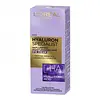What's inside
What's inside
 Key Ingredients
Key Ingredients

 Benefits
Benefits

 Concerns
Concerns

 Ingredients Side-by-side
Ingredients Side-by-side

Water
Skin ConditioningSodium Hyaluronate
HumectantPrunus Amygdalus Dulcis Oil
Skin ConditioningOlus Oil
EmollientTocopherol
AntioxidantPolyglyceryl-6 Stearate
EmollientPolyglyceryl-6 Behenate
Emulsion StabilisingGlycerin
HumectantMethylpropanediol
SolventSqualane
EmollientIsocetyl Stearate
EmollientCaprylic/Capric Triglyceride
MaskingDecyl Isostearate
EmollientIsostearyl Isostearate
EmollientCetearyl Alcohol
EmollientGlyceryl Stearate
EmollientMicrocrystalline Cellulose
AbsorbentXanthan Gum
EmulsifyingTrehalose
HumectantHydrogenated Polydecene
EmollientChlorella Vulgaris Extract
Skin ConditioningStearic Acid
CleansingTocopheryl Acetate
AntioxidantPropanediol
SolventHydrolyzed Glycosaminoglycans
HumectantHydrolyzed Hyaluronic Acid
HumectantHyaluronic Acid
HumectantSodium Hyaluronate Crosspolymer
HumectantAllantoin
Skin ConditioningPolyacrylamide
C13-14 Isoparaffin
EmollientLaureth-7
EmulsifyingDehydroacetic Acid
PreservativeBenzyl Alcohol
PerfumingPhenoxyethanol
PreservativeBenzyl Glycol
SolventEthylhexylglycerin
Skin ConditioningRaspberry Ketone
MaskingParfum
MaskingWater, Sodium Hyaluronate, Prunus Amygdalus Dulcis Oil, Olus Oil, Tocopherol, Polyglyceryl-6 Stearate, Polyglyceryl-6 Behenate, Glycerin, Methylpropanediol, Squalane, Isocetyl Stearate, Caprylic/Capric Triglyceride, Decyl Isostearate, Isostearyl Isostearate, Cetearyl Alcohol, Glyceryl Stearate, Microcrystalline Cellulose, Xanthan Gum, Trehalose, Hydrogenated Polydecene, Chlorella Vulgaris Extract, Stearic Acid, Tocopheryl Acetate, Propanediol, Hydrolyzed Glycosaminoglycans, Hydrolyzed Hyaluronic Acid, Hyaluronic Acid, Sodium Hyaluronate Crosspolymer, Allantoin, Polyacrylamide, C13-14 Isoparaffin, Laureth-7, Dehydroacetic Acid, Benzyl Alcohol, Phenoxyethanol, Benzyl Glycol, Ethylhexylglycerin, Raspberry Ketone, Parfum
Water
Skin ConditioningDimethicone
EmollientGlycerin
HumectantSilica
AbrasiveAcrylamide/Sodium Acryloyldimethyltaurate Copolymer
Emulsion StabilisingPrunus Armeniaca Kernel Oil
MaskingAdenosine
Skin ConditioningCaffeine
Skin ConditioningDisodium EDTA
Hydroxyethylpiperazine Ethane Sulfonic Acid
BufferingSodium Hyaluronate
HumectantTriethanolamine
BufferingTocopheryl Acetate
AntioxidantAcrylates/C10-30 Alkyl Acrylate Crosspolymer
Emulsion StabilisingCI 77891
Cosmetic ColorantIsohexadecane
EmollientMica
Cosmetic ColorantPolysorbate 80
EmulsifyingSorbitan Oleate
EmulsifyingTin Oxide
AbrasiveDimethicone/Vinyl Dimethicone Crosspolymer
Skin ConditioningDimethiconol
EmollientChlorphenesin
AntimicrobialPhenoxyethanol
PreservativeWater, Dimethicone, Glycerin, Silica, Acrylamide/Sodium Acryloyldimethyltaurate Copolymer, Prunus Armeniaca Kernel Oil, Adenosine, Caffeine, Disodium EDTA, Hydroxyethylpiperazine Ethane Sulfonic Acid, Sodium Hyaluronate, Triethanolamine, Tocopheryl Acetate, Acrylates/C10-30 Alkyl Acrylate Crosspolymer, CI 77891, Isohexadecane, Mica, Polysorbate 80, Sorbitan Oleate, Tin Oxide, Dimethicone/Vinyl Dimethicone Crosspolymer, Dimethiconol, Chlorphenesin, Phenoxyethanol
 Reviews
Reviews

Ingredients Explained
These ingredients are found in both products.
Ingredients higher up in an ingredient list are typically present in a larger amount.
Glycerin is already naturally found in your skin. It helps moisturize and protect your skin.
A study from 2016 found glycerin to be more effective as a humectant than AHAs and hyaluronic acid.
As a humectant, it helps the skin stay hydrated by pulling moisture to your skin. The low molecular weight of glycerin allows it to pull moisture into the deeper layers of your skin.
Hydrated skin improves your skin barrier; Your skin barrier helps protect against irritants and bacteria.
Glycerin has also been found to have antimicrobial and antiviral properties. Due to these properties, glycerin is often used in wound and burn treatments.
In cosmetics, glycerin is usually derived from plants such as soybean or palm. However, it can also be sourced from animals, such as tallow or animal fat.
This ingredient is organic, colorless, odorless, and non-toxic.
Glycerin is the name for this ingredient in American English. British English uses Glycerol/Glycerine.
Learn more about GlycerinPhenoxyethanol is a preservative that has germicide, antimicrobial, and aromatic properties. Studies show that phenoxyethanol can prevent microbial growth. By itself, it has a scent that is similar to that of a rose.
It's often used in formulations along with Caprylyl Glycol to preserve the shelf life of products.
Sodium Hyaluronate is hyaluronic acid's salt form. It is commonly derived from the sodium salt of hyaluronic acid.
Like hyaluronic acid, it is great at holding water and acts as a humectant. This makes it a great skin hydrating ingredient.
Sodium Hyaluronate is naturally occurring in our bodies and is mostly found in eye fluid and joints.
These are some other common types of Hyaluronic Acid:
Learn more about Sodium HyaluronateTocopheryl Acetate is AKA Vitamin E. It is an antioxidant and protects your skin from free radicals. Free radicals damage the skin by breaking down collagen.
One study found using Tocopheryl Acetate with Vitamin C decreased the number of sunburned cells.
Tocopheryl Acetate is commonly found in both skincare and dietary supplements.
Learn more about Tocopheryl AcetateWater. It's the most common cosmetic ingredient of all. You'll usually see it at the top of ingredient lists, meaning that it makes up the largest part of the product.
So why is it so popular? Water most often acts as a solvent - this means that it helps dissolve other ingredients into the formulation.
You'll also recognize water as that liquid we all need to stay alive. If you see this, drink a glass of water. Stay hydrated!
Learn more about Water